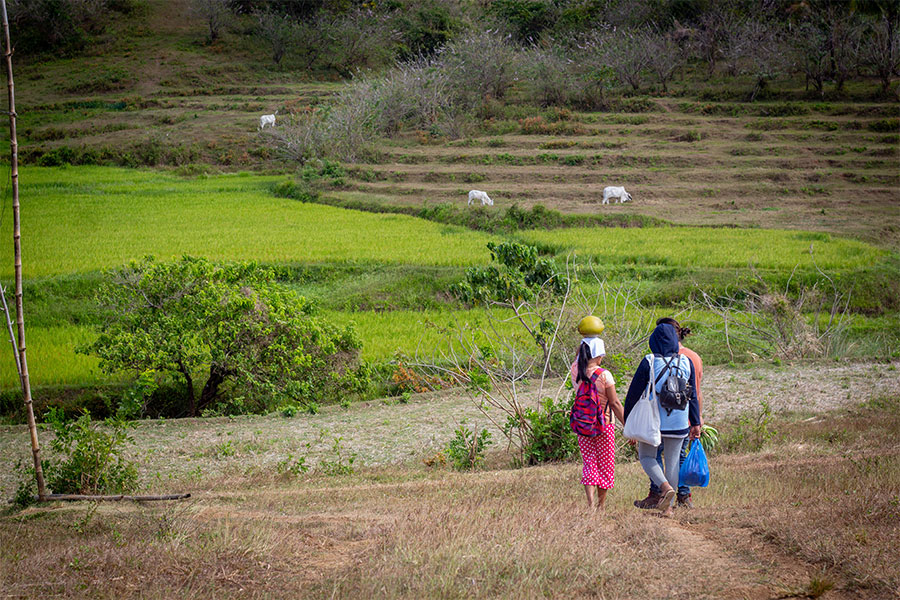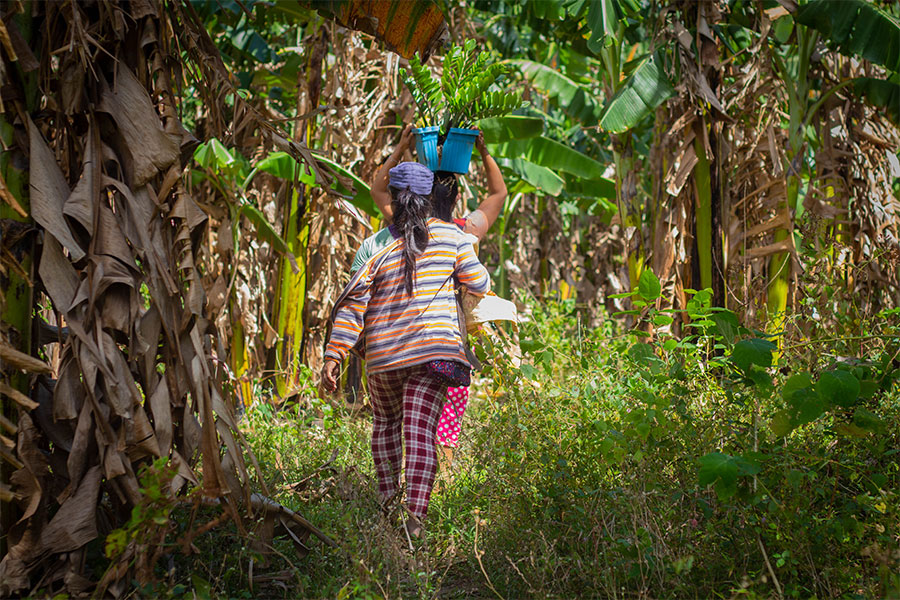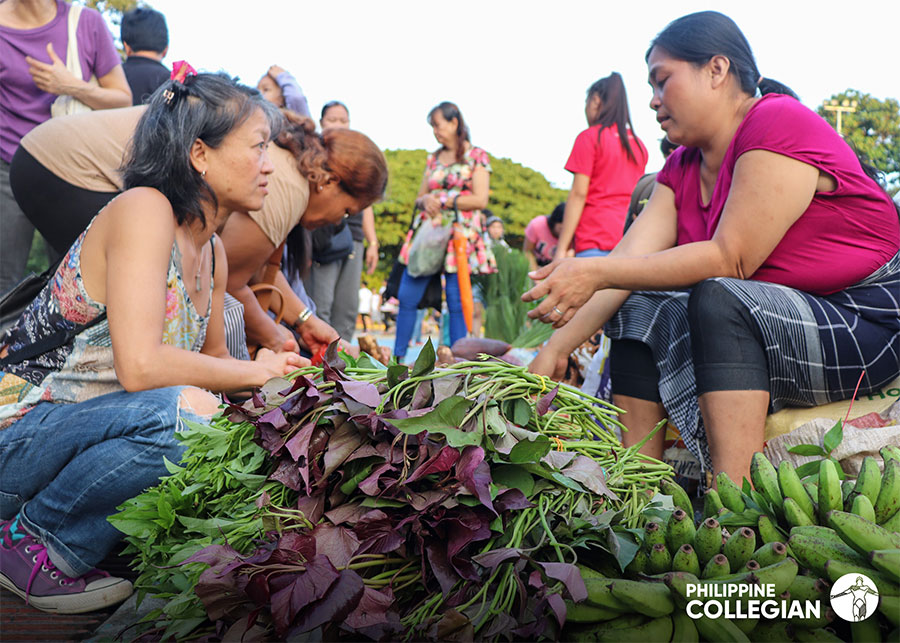BULACAN, Philippines – While governments around the world scramble to cushion the impact of the COVID-19 pandemic primarily on cities, not much has been clamored, at the same pitch, about relief for rural communities where the crisis has also rippled across. Their vulnerabilities are doubly sharpened in light of startlingly deficient aid and inequalities in access to resources that, in the first place, they have been grappling with for so long.
In lieu of an inclusive and humanitarian response that takes care of the most vulnerable, blanket restrictions have been in place in entire cities and regions. In the Philippines, what is perceived by some sectors as an ill-coordinated island-wide quarantine imposed since March 16 has slackened the flow of goods. Trucks bearing farm produce from provinces now form long queues at police and military checkpoints on the borders of city centers.
This is also true, the other way around, for the likes of San Mateo, a poor village in Norzagaray, Bulacan (some 49 kilometers north of Manila) where scores of families have been eking out paltry wages since a mass eviction last October forced them out of their homes on lands they had been cultivating for decades. The COVID-19 lockdown order left them with uncertain prospects. The ones who had found jobs like construction work in Metro Manila now find themselves stranded from their only source of income. With nonessential work shut down, to get by each day would be a tall order until the lockdown is lifted. Farmers turned food vendors lament how even food supplies coming in from other farms have reportedly been denied entry.
It is no less than a tragic irony that some of the country’s food producers would now have to scrape the bottom of the barrel for food they could have grown. To blame this misfortune on the COVID-19 pandemic, however, would be to discount the long history of land grabs and displacements that have exacerbated the precarity of the farmers’ lives, to begin with.
Their struggle for land and resources has taken on greater urgency in the face of a public health emergency that threatens to fray the threadbare support they rely on to brave out daily disasters.
Fat of the Land
Amid the lockdown, admonitions against staying out of the streets lose touch with the reality for farmers in Norzagaray who have no homes to return to. Their land had carried them through dire straits long before a real estate developer swooped in and dragged them through a dispute over legal titles and tenancy.
It was a puzzle to Andres* how the 75.5-hectare land in Sitio Compra in San Mateo village, which he had helped till for as long as he could recall, came into the possession of a company he had not heard of until lately. Born and raised here, he remembered how his mother used to talk about a certain Roman Aquino, the landowner whom his family and other tenants paid land rent to since the 1950s.
Yet, unbeknownst to them, Aquino’s children sold their rights and interests to Royal Moluccan Realty Holdings, Inc. (RMRHI) in 1988, despite a litigation, then underway since 1956, between the Aquinos and another group of claimants to whom the former allegedly executed a deed of absolute sale. The conflict lasted for over another decade, with the country’s Court of Appeals (CA) awarding the title to RMRHI for USD 98,000.
This legal battle went on while the unwitting farmer tenants continued to work the land and taught the next generation to keep it on. Soon, settlers arrived and learned to take on farming, too. Andres met and married one of them, Karen*, in 2005. They grew on a plot of land at the foot of the mountains all manner of fruits like bananas, soursop, and guava, and would bring their kids with them during harvest season.
“We’d bring plastic bags and umbrellas,” Karen said. “Even if it was raining, we’d still go on. I’d just drape a jute sack over my kids’ heads and tell them to wait for me in the shade.”
They shared the land with a host of other peasant households who, until 2005, when RMRHI came and staked its claim, developed the land as theirs. In May 2006, the notice of coverage issued by government’s Department of Agrarian Reform (DAR) — which identified the land as up for distribution to beneficiaries, as part of the government’s comprehensive agrarian reform program (CARP) — would have been good news, if it had not been contested by RMRHI.
What followed was a series of land rights claims, appeals, and a drawn-out engagement with courts and executive adjudication bodies.

In February 2007, RMRHI filed an application for exemption of the landholding from CARP, which, based on the land reform law Republic Act (RA) 6657 Section 10, relieves lands with slopes of over 18% from redistribution. The law derives its justification from an American-era commonwealth act that classified said lands as unsuitable for farming and unavailable for disposition, but necessary for forestry as part of the public domain.
For two of Karen’s friends, Marie* and Ester*, what the law says does not square with their experience. They grew plentiful of bananas on the leeward side of the mountain that bisects the land into an uphill part and a flatland. Come peak season, they would carry the ripest bunch downhill to sell at the market.
Still, the real estate company’s appeal was granted, if only to a certain degree. The DAR Regional Office issued an order in September 2007, maintaining that portions of the land with below 18% in slope, plus those found to have been developed prior to the implementation of CARP, were still to be given out to the farmers. It then placed these parcels under the agrarian reform law’s compulsory acquisition scheme.
Though, in the same order, the DAR told RMRHI to segregate the exempted portions at its own expense, the developer somehow moved to withdraw its appeal. A couple of years later, DAR granted the motion to withdraw. But, once again, RMRHI backpedaled and, from 2009 to 2015, asked DAR to reconsider its decision, contending that all portions with slope 18% and above should be totally exempt, regardless of whether they had been farmed before the agrarian reform took effect.
“They just want to get everything. Five hectares—that’s just not enough. That doesn’t sit well with them,” Karen said, referring to the size of land that RMRHI could have rightly claimed—less than a tenth of the total land area in question—if only it had not gone on to drag out its appeal.
RMRHI asserted that it also need not provide compensation to the tillers who would be displaced from the uplands. Because DAR stood by its original decision, the company elevated the case to the Office of the President, which also dismissed it for lack of merit and ruled in favor of the farmer beneficiaries.
“We have something concrete to hold on to,” Karen said. “We’re confident, because all these documents favor us. How can they say we have no rights, that we’ve lost?”
But the decision of the Office of the President in December 2015 failed to deter RMRHI. The company pursued the case it had filed before both the DAR Adjudication Board (DARAB) and the judicial courts since 2010, even going as far as the regional trial court, to argue against the tenancy of the Norzagaray farmers.
RMRHI reasoned that the beneficiaries of the portions of the land covered by CARP — including those that had been developed before the program was signed into law in June 1988 — could only be farmers who have lived in the area since way before the 1980s, including their descendants. Settlers and so-called outsider farmers, or those who worked the land but resided outside the community, could not rightly own the land, then, according to RMRHI.
In 2018, the DARAB’s sheriff decided in favor of the developer and later released a writ of demolition. The order went on to set a dangerous precedent for the state-supported violence the farmers would confront in defense of the land that they thought, all along, the law had agreed to be theirs.
Law of the Land
Together with more than 50 personnel of the Philippine National Police (PNP) Norzagaray, armed goons of RMRHI, and DARAB officials, a 30-strong demolition team tore down 26 houses and destroyed other properties of the farmer families in the area, in February 2018.
Andres’s cousin’s house was one of those first razed to rubble. “He was still inside when it happened. He didn’t understand what was happening even when they were ripping everything to pieces around him. He had this sundry store next door that they emptied out,” Karen said. “Even money and jewelry were not spared. It all happened so fast.”
A seven-year-old child was still reportedly inside another house when the demolishers carried out the wipeout within just a few hours. Other kids were up and about, then, and shook in fear as they looked on helplessly. Local media reported that a teenager suffered seizures in the middle of all this and was rushed to the hospital.
Marie’s house up on the hill proved too much of a trouble to reach for the demolishers. She recalled how, even without a court order, the operations pushed through. Some community members who RMRHI had frightened into surrendering their land had had their signatures attached to an attendance sheet, which was later used as proof that a pre-demolition conference had supposedly taken place.
“My sibling was one of them… PHP 30,000 (about USD 580) was hard to turn down,” Marie said, referring to the compensation that RMRHI had offered for every household. “Plus, of course, we only have machetes. That’s no match to the goons’ guns.” Most of the residents who had taken up RMRHI’s offer only built a house on the land, Marie said. “Those of us who stayed are farmers. We need the land to survive.”

Yet the demolition had since crippled their earnings. A checkpoint at the main road barred the delivery of harvests into and out of the farm. Private security guards of RMRHI were deployed and roamed the area. They tacked “No Trespassing” signs onto the barbed wire strung all around, except on the hilly side that some farmers later discovered they could cut through to get to their crops and still sneak away harvest.
They found a small portion of the land they could still till. “But it was just like ‘guerilla warfare,’ as we call it,” former lawmaker Ariel Casilao of the pro-peasant partylist Anakpawis quipped, citing how farmers had to be extra-careful not to get caught by the guards or on the CCTVs installed around the perimeter.
In September 2018, Casilao joined other farmers’ rights groups in a fact-finding and solidarity mission in the area and launched bungkalan, a land occupation and cultivation campaign, on a one-hectare land. No sooner had the mission ended than the goons rooted out the crops and demolished the makeshift hut the farmers had assembled to house the bungkalan participants.
“Bungkalan is one of the highest forms of collective action to assert the right to land,” Casilao said. “Bit by bit, we strive to raise the farmers’ consciousness about the struggle for land that is not confined to just the legal aspect. It should be complementary. We confront the legal issues, all the legal needs of the case — whether in court, before DAR, or at the local government level — until we get to wherever it takes us, be it in the Supreme Court or the CA.”
In January 2019, Casilao co-authored two resolutions in Congress regarding the matter. Both urged the parliament’s committees on agrarian reform and on human rights to conduct an investigation, in aid of legislation, on the lethargic implementation of land distribution to the prospective peasant beneficiaries and on the violent demolition the latter had faced the year before.
The cogs of parliamentary bureaucracy, however, squeaked into motion so belatedly that, before the congressional committees could begin any inquiry, another wave of demolition swept the community.
Lay of the Land
Marie found her house burned to smithereens. It was a complete turnaround of fortune from a few days before. She and several other women farmers had earned handsomely from selling vegetable produce at a pop-up market set up in the middle of a park in Quezon City, a one-and-a-half ride away from Norzagaray.

“I’ll never forget the faces of those who did it,” Marie said. “They’re still around.” The RMRHI security guards assisted a demolition crew comprising more than 80 individuals who had been paid and sent in from Sapang Palay, a village in the nearby city of San Juan Del Monte, Bulacan. They burned down two houses along with Marie’s, while a row of others was demolished in the morning of October 23.
No court order, however, was presented to justify the hasty clearing operations. Neither did the residents receive a prior notice which they should have been furnished at least a month before the date of eviction, per the Urban Development and Housing Act (UDHA) of 1992. The demolition team instead presented a permit from the Municipal Engineering Office of Norzagaray, citing supposed violations of the building code.
Yet the farmers argued that it was not, in the first place, within the ambit of the municipal engineer’s power to allow the demolition of houses built on lands classified as agricultural instead of residential or mixed-use. “We don’t own mansions, just thatched huts. Why would they demand building permits from us?” said Karen, whose house similarly fell prey, alongside 11 others, to the illegal wipeout.
For Ester, there was no way to recover the USD 250 that the goons stole before ripping her house down and setting it afire. She said she would have spent the money on a carabao. The thought of another cropping season, though, seemed too far-fetched, then, as she and her neighbors watched demolishers ruin their belongings. Some even slashed open a sack of unmilled rice and scattered it all over the place.
Several residents looked to the local police for help, to no avail. Meanwhile, the village authorities said they only received the report at midnight. “Is that even possible? What kind of office receives paperwork at midnight?” Marie said.
Only because she had nowhere else to turn to did she again approach the village chief several months later. It was Christmas. Her 11-year-old son accompanied her husband on an errand back to the shell of their old house, now enclosed within an area fenced off with galvanized iron sheets. The child stayed put while his father went off to herd back and tether their cow. Before long, gunshots rang out. He ran crying into the woods till he chanced on an old neighbor. He said he thought his father had been shot to death.
Just like before, however, the village authorities left Marie waiting for a few hours before accommodating her complaint. She feared, too, that where they had relocated, in a rental apartment near the village hall, was no help in appeasing her son’s anxiety and trauma.
“Just the other night, at midnight, we couldn’t sleep. Gunshots could be heard coming from just across the village hall,” she said, having counted seven blasts all in all. “But nobody even bothered to tell off those goons.”
In Ester’s case, a farmer household from a village close by took her family in as tenants. She continued to farm but could no longer sell her produce at a profit. Karen’s family, in the meantime, settled not far away from their walled-off farm in Sitio Compra, tightening the purse strings to squeak by on Andres’s USD 10 daily salary as a construction worker in an adjacent city. He worried his contract would expire soon.
Still, many of them believe they could still return to their old ways. All hope is not lost, even on the legal front, said former DAR Secretary Rafael Mariano. All the authorities that should have safeguarded them against attacks could still rectify bureaucratic lapses and deliver redress for all peasant victims, according to Mariano, who also used to chair the Asian Peasant Coalition (APC).
The peasant leader cited, for one, the first ocular inspection report that DAR has yet to release. Should it find that there had been illegal and premature land conversion in the area, the regional office must issue a cease and desist order against RMRHI. Whether the farmers in Norzagaray could be considered tenants is moot, because the case, he said, should rather center on their legitimacy as potential agrarian reform beneficiaries.
“That’s why it’s crucial that the entire process of acquisition and distribution continue, as stated by law,” Mariano said, “despite whatever concurrent case is being sought in the courts.”
During his stint as the DAR chief, Mariano made it a point to emphasize during dialogues with farmers’ groups that the government, while bound by its mandate, could only actually endeavor to guarantee that those who have less in life would have more in law. Ultimately, the first port of call should come from within the consolidated ranks of the rural people.
“The peasant sector, as a mass movement, with their organized struggles, should be the decisive force in advancing the people’s right to land,” Mariano said.
Indeed, the Norzagaray farmers only have one another to pull through this ordeal. When, once, the armed guards caught one of them “stealing” away her harvest, the rest went to the police station to clamor for her release. They learned some village officials tried to force her to sign off on an affidavit withdrawing the charges of theft, arson, and malicious mischief that they had filed against two of the RMRHI goons.
“They thought they could fool us,” Marie said. “If they’re looking for criminals, it’s those land grabbers!”
There is no shortage of support they gather from even the seemingly unlikeliest groups. A local church has gone so far as to open its doors to them, offering to host their meetings now that they have been driven out of their lands.
In the days ahead, they also hope to get enough relief and financial subsidies to set up a community kitchen at the church. There they could feed farmer families who can neither work at their farms anymore, nor transport supplies to and from the province, amid the lockdown expected to last for at least a month.
The pandemic looms like another crisis they have to ride out until, once the dust settles, they will carry on standing their ground for the land that is, after all, theirs for the taking.
* All the names used are not real. They were given anonymity for security purposes. 
#NoLandNoLife Features discuss recent developments, events, and trends on land and resource grabbing and related human rights issues in the region as well as the factors and forces that drive it. Send us your feedback at nolandnolife@panap.net.








Discussion about this post